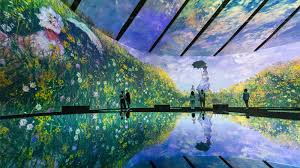Unlocking the Magic of Immersive Experiences: A Journey into Virtual Realms
Exploring the World of Immersive Experiences
Immersive experiences have become a popular trend in the world of entertainment and technology, offering participants a chance to step into new and captivating environments that engage all their senses. From virtual reality simulations to interactive art installations, these experiences transport individuals to alternate realities where they can explore, learn, and create unforgettable memories.
The Rise of Immersive Technology
Advancements in technology have played a significant role in the rise of immersive experiences. Virtual reality (VR) headsets, augmented reality (AR) apps, and interactive installations have opened up new possibilities for creating immersive worlds that blur the lines between fiction and reality. These technologies allow users to interact with digital environments in ways that were previously unimaginable.
Diverse Applications
Immersive experiences are not limited to entertainment; they also have practical applications in various industries. For example, VR training simulations are used to train professionals in fields such as medicine, aviation, and engineering. Museums and cultural institutions use AR apps to provide interactive exhibits that enhance visitors’ understanding of history and art.
The Power of Immersion
What sets immersive experiences apart is their ability to engage participants on a deep emotional level. By creating environments that surround users with sights, sounds, and sensations, these experiences evoke strong feelings of presence and connection. Participants often report feeling transported to another world or time, making the experience truly unforgettable.
The Future of Immersion
As technology continues to evolve, the possibilities for immersive experiences are endless. Innovations such as haptic feedback systems, scent generators, and artificial intelligence promise to make immersive experiences even more lifelike and engaging. Whether used for entertainment, education, or therapy, immersive technology is sure to shape the future of how we experience the world around us.
Exploring Immersive Experiences: Common Questions and Insights
- What are immersive experiences?
- How do immersive experiences work?
- What technologies are used to create immersive experiences?
- What industries benefit from immersive experiences?
- Are there different types of immersive experiences?
- How can I participate in immersive experiences?
- What are the benefits of engaging in immersive experiences?
- What does the future hold for immersive technology?
What are immersive experiences?
Immersive experiences are interactive encounters that fully engage the senses and transport individuals into captivating environments where reality and fiction blend seamlessly. These experiences often involve advanced technologies such as virtual reality (VR) and augmented reality (AR) to create realistic simulations that immerse participants in alternate worlds or scenarios. By stimulating sight, sound, touch, and sometimes even smell, immersive experiences offer a deeply engaging and memorable way for individuals to explore, learn, and connect with their surroundings in a unique and transformative manner.
How do immersive experiences work?
Immersive experiences work by leveraging technology and creative design to transport participants into engaging and interactive environments that stimulate multiple senses. Through the use of techniques such as virtual reality, augmented reality, interactive storytelling, and sensory feedback, immersive experiences create a sense of presence and immersion that blurs the boundaries between the physical and digital worlds. By combining visual, auditory, tactile, and sometimes olfactory stimuli, these experiences aim to evoke emotional responses and deep engagement from participants, allowing them to explore new realities and narratives in a truly captivating way.
What technologies are used to create immersive experiences?
Various cutting-edge technologies are used to create immersive experiences that captivate users’ senses and transport them to new worlds. Virtual reality (VR) headsets, augmented reality (AR) applications, motion tracking sensors, haptic feedback devices, and spatial audio systems are just a few examples of the technologies employed in crafting immersive environments. These tools work together to create realistic simulations that engage users visually, audibly, and even physically, allowing them to interact with digital content in ways that feel incredibly lifelike. By combining these technologies creatively, designers and developers can push the boundaries of what is possible in the realm of immersive experiences.
What industries benefit from immersive experiences?
Various industries benefit from immersive experiences, leveraging technology to enhance engagement and deliver unique experiences to their audiences. Entertainment and gaming industries have embraced virtual reality (VR) and augmented reality (AR) to create immersive worlds for users to explore. Education sectors use immersive experiences to make learning more interactive and engaging, while healthcare professionals utilise VR simulations for training and therapy purposes. Additionally, tourism companies offer virtual tours through AR apps, and marketing agencies use immersive technology to create memorable brand experiences. Overall, industries across the board are recognising the value of immersive experiences in captivating audiences and driving innovation.
Are there different types of immersive experiences?
When exploring the realm of immersive experiences, it becomes evident that there are indeed various types that cater to diverse preferences and interests. From virtual reality (VR) simulations that transport users to entirely digital worlds to augmented reality (AR) applications that overlay digital content onto the physical environment, the spectrum of immersive experiences is vast and continually expanding. Interactive art installations, escape rooms, 4D cinema experiences, and sensory exhibits are just a few examples of the diverse range of immersive encounters available. Each type offers a unique way to engage participants and captivate their senses, ensuring that there is something for everyone seeking to delve into the world of immersive experiences.
How can I participate in immersive experiences?
To participate in immersive experiences, there are various avenues you can explore depending on your interests and access to technology. One popular option is to visit immersive art installations, museums, or theme parks that offer interactive exhibits and virtual reality experiences. Additionally, you can attend events or festivals dedicated to immersive technologies where you can try out the latest innovations firsthand. If you prefer a more accessible option, there are many virtual reality apps and games available for download that allow you to immerse yourself in different virtual worlds from the comfort of your own home. Embracing immersive experiences is about being open to new adventures and seeking out opportunities to engage with technology and art in innovative ways.
What are the benefits of engaging in immersive experiences?
Engaging in immersive experiences offers a multitude of benefits that cater to both personal enrichment and professional growth. By stepping into immersive environments, individuals can enhance their creativity, critical thinking skills, and problem-solving abilities through interactive challenges and simulations. These experiences also provide a unique opportunity for emotional connection and empathy-building, as participants are able to see the world from different perspectives. Additionally, immersive experiences can serve as a form of escapism, offering moments of relaxation and rejuvenation in a digitally immersive setting. Overall, the benefits of engaging in immersive experiences extend beyond entertainment, providing a platform for personal development and exploration in an ever-evolving technological landscape.
What does the future hold for immersive technology?
The future of immersive technology holds immense potential for revolutionising the way we interact with digital environments. As advancements in virtual reality, augmented reality, and sensory technologies continue to push boundaries, we can expect even more realistic and engaging immersive experiences to emerge. From enhanced training simulations and interactive storytelling to innovative applications in healthcare and education, immersive technology is poised to transform various industries and enhance our daily lives. With ongoing research and development, the future of immersive technology promises a world where the lines between physical and digital realities blur, offering new opportunities for creativity, learning, and connection.


